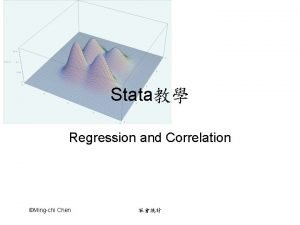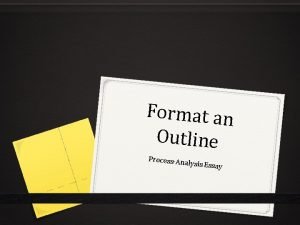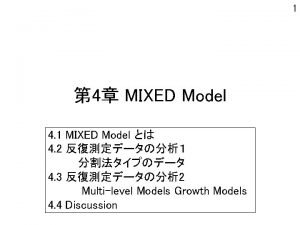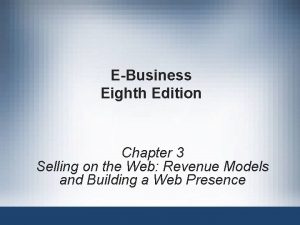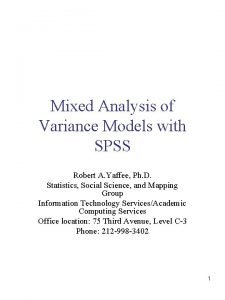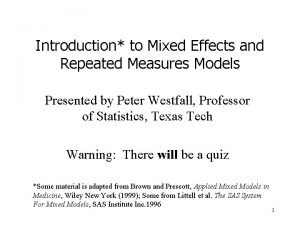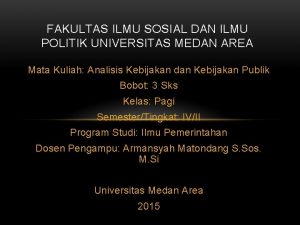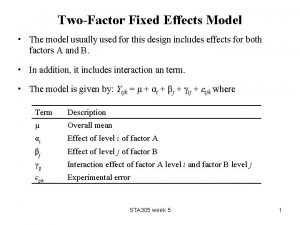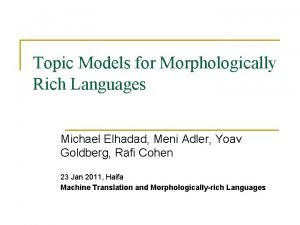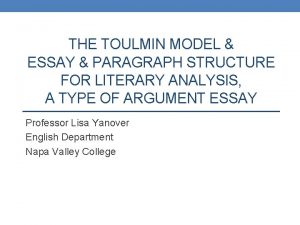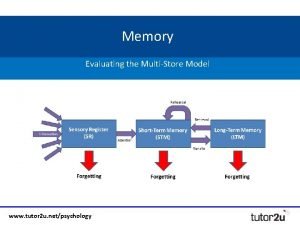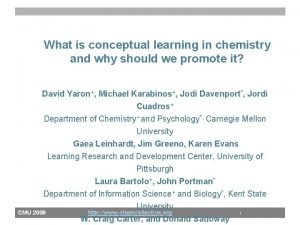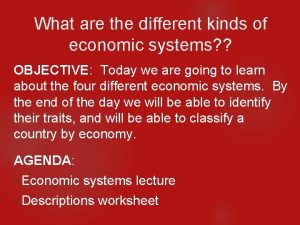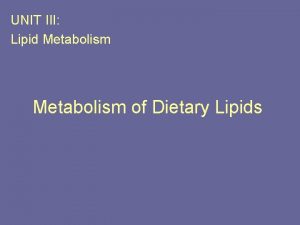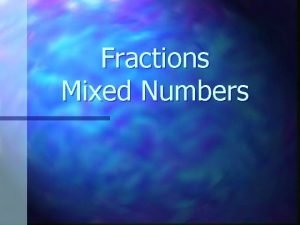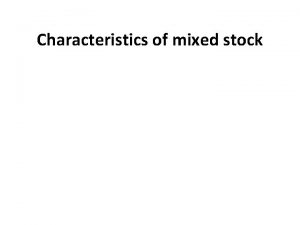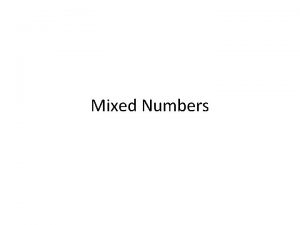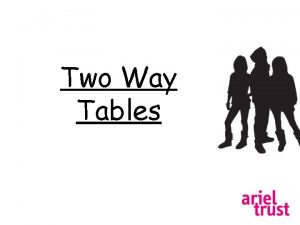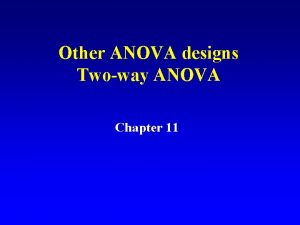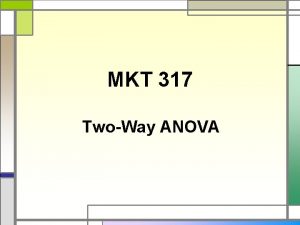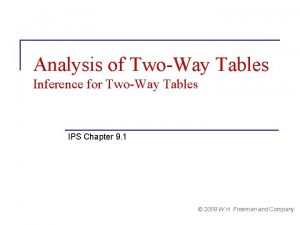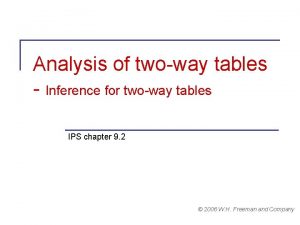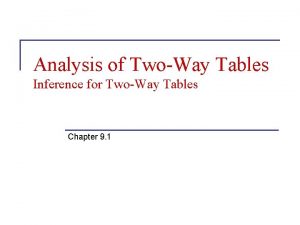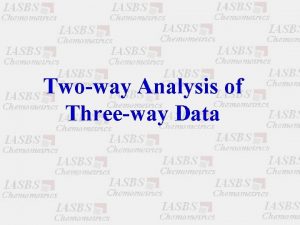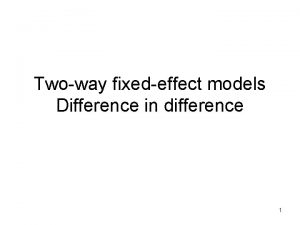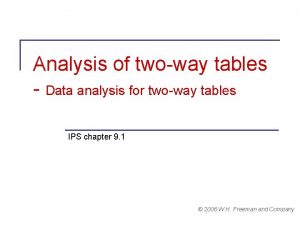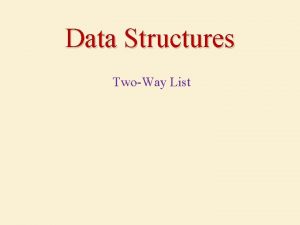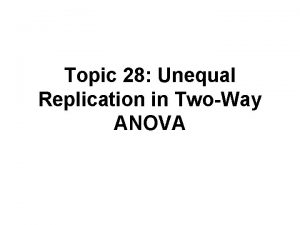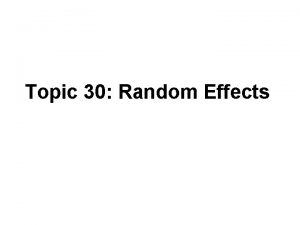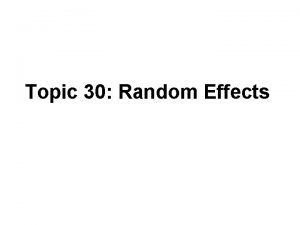Topic 32 TwoWay Mixed Effects Model Outline Twoway





























- Slides: 29

Topic 32: Two-Way Mixed Effects Model

Outline • Two-way mixed models • Three-way mixed models

Data for two-way design • Y is the response variable • Factor A with levels i = 1 to a • Factor B with levels j = 1 to b • Yijk is the kth observation in cell (i, j) k = 1 to nij • Have balanced designs with n = nij

Two-way mixed model • Two-way mixed model has – One fixed effect – One random effect • Tests: – Again use EMS as guide – Two possible models • Unrestricted mixed model (SAS) • Restricted mixed model (Text)

KNNL Example • KNNL Problem 25. 15, p 1080 • Y is fuel efficiency in miles per gallon • Factor A represents four different drivers, a=4 levels • Factor B represents five different cars of the same model , b=5 • Each driver drove each car twice over the same 40 -mile test course

Read and check the data a 1; infile 'c: . . . CH 25 PR 15. TXT'; input mpg driver car; proc print data=a 1; run;

The data Obs 1 2 3 4 5 6 7 8 9 10 mpg 25. 3 25. 2 28. 9 30. 0 24. 8 25. 1 28. 4 27. 9 27. 1 26. 6 driver 1 1 1 1 1 car 1 1 2 2 3 3 4 4 5 5

Prepare the data for a plot data a 1; set a 1; if (driver eq 1)*(car eq 1) then dc='01_1 A'; if (driver eq 1)*(car eq 2) then dc='02_1 B'; ⋮ if (driver eq 4)*(car eq 5) then dc='20_4 E';

Plot the data title 1 'Plot of the data'; symbol 1 v=circle i=none c=black; proc gplot data=a 1; plot mpg*dc/frame; run;


Find the means proc means data=a 1; output out=a 2 mean=avmpg; var mpg; by driver car;

Plot the means title 1 'Plot of the means'; symbol 1 v='A' i=join c=black; symbol 2 v='B' i=join c=black; symbol 3 v='C' i=join c=black; symbol 4 v='D' i=join c=black; symbol 5 v='E' i=join c=black; proc gplot data=a 2; plot avmpg*driver=car/frame; run;


Example Revisited • Suppose that the four drivers were not randomly selected and there is interest in comparing the four drivers in the study • Driver (A) is now a fixed effect • Still consider Car (B) to be a random effect

Mixed effects model (unrestricted) • Yijk = μ + i + j + ( )ij + εijk • Σ i =0 (unknown constants) • j ~ N(0, σ 2) • ( )ij ~ N(0, σ 2) • εij ~ N(0, σ2) • σY 2 = σ 2 + σ2

Mixed effects model (restricted) • Yijk = μ + i + j + ( )ij + εijk • Σ i =0 (unknown constants) • • Σ( b)ij =0 for all j • εij ~ N(0, σ2) • σY 2 = σ 2 + ((a-1)/a)σ 2 + σ2

Parameters • There a+3 parameters in this model – a fixed effects means – σ 2 – σ2

ANOVA table • The terms and layout of the ANOVA table are the same as what we used for the fixed effects model • The expected mean squares (EMS) are different and vary based on the choice of unrestricted or restricted mixed model

EMS (unrestricted) • • • E(MSA) = σ2 + bnΣ i 2 /(a-1)+ nσ 2 E(MSB) = σ2 + anσ 2 + nσ 2 E(MSAB) = σ2 + nσ 2 E(MSE) = σ2 Estimates of the variance components can be obtained from these equations, replacing E(MS) with table value, or other methods such as ML

EMS (restricted) • • • E(MSA) = σ2 + bnΣ i 2 /(a-1)+ nσ 2 E(MSB) = σ2 + anσ 2 Diff 2 2 E(MSAB) = σ + nσ here 2 E(MSE) = σ Estimates of the variance components can be obtained from these equations, replacing E(MS) with table value, or other methods such as ML

Hypotheses (unrestricted) • H 0 A: σ 2 = 0; H 1 A: σ 2 ≠ 0 – H 0 A is tested by F = MSA/MSAB with df a -1 and (a-1)(b-1) • H 0 B: σ 2 = 0; H 1 B : σ 2 ≠ 0 – H 0 B is tested by F = MSB/MSAB with df b -1 and (a-1)(b-1) • H 0 AB : σ 2 = 0; H 1 AB : σ 2 ≠ 0 – H 0 AB is tested by F = MSAB/MSE with df (a-1)(b-1) and ab(n-1)

Hypotheses (restricted) • H 0 A: σ 2 = 0; H 1 A: σ 2 ≠ 0 – H 0 A is tested by F = MSA/MSAB with df a -1 and (a-1)(b-1) • H 0 B: σ 2 = 0; H 1 B : σ 2 ≠ 0 – H 0 B is tested by F = MSB/MSE with df b 1 and ab(n-1) • H 0 AB : σ 2 = 0; H 1 AB : σ 2 ≠ 0 – H 0 AB is tested by F = MSAB/MSE with df (a-1)(b-1) and ab(n-1)

Comparison of Means • To compare fixed levels of A, std error is • Degrees of freedom for t tests and CIs are then (a-1)(b-1) • This is true for both unrestricted and restricted mixed models

Using Proc Mixed proc mixed data=a 1; class car driver; model mpg=driver; random car*driver / vcorr; lsmeans driver / adjust=tukey; run; SAS considers unrestricted model only…results in slightly different variance estimates

SAS Output Covariance Parameter Estimates Cov Parm Estimate car 2. 9343 car*driver 0. 01406 Residual 0. 1757 Type 3 Tests of Fixed Effects Num Den Effect DF DF F Value Pr > F driver 3 12 458. 26 <. 0001

SAS Output Effect driver driver 1 2 3 4 Least Squares Means Standard Estimate Error DF t Value Pr > |t| 26. 9300 0. 7793 12 34. 56 <. 0001 34. 1500 0. 7793 12 43. 82 <. 0001 28. 8500 0. 7793 12 37. 02 <. 0001 30. 2600 0. 7793 12 38. 83 <. 0001

SAS Output Differences of Least Squares Means Effect driver _driver 1 2 driver 1 3 driver 1 4 driver 2 3 driver 2 4 driver 3 4 Standard Estiate Error DF t Value Pr > |t| Adjustment Adj P <. 0001 -7. 2200 0. 2019 12 -35. 76 <. 0001 Tukey. Kramer <. 0001 -1. 9200 0. 2019 12 -9. 51 <. 0001 Tukey. Kramer <. 0001 -3. 3300 0. 2019 12 -16. 49 <. 0001 Tukey. Kramer <. 0001 5. 3000 0. 2019 12 26. 25 <. 0001 Tukey. Kramer <. 0001 3. 8900 0. 2019 12 19. 26 <. 0001 Tukey. Kramer <. 0001 -1. 4100 0. 2019 12 -6. 98 <. 0001 Tukey. Kramer

Three-way models • We can have zero, one, two, or three random effects • EMS indicate how to do tests • In some cases the situation is complicated and we need approximations of an F test, e. g. when all are random, use MS(AB)+MS(AC)MS(ABC) to test A

Last slide • Finish reading KNNL Chapter 25 • We used program topic 32. sas to generate the output for today
 Stata 教學
Stata 教學 Quotation sandwich examples
Quotation sandwich examples General topic example
General topic example Tapic about internet
Tapic about internet Making an outline
Making an outline A topic outline uses
A topic outline uses Dbq thesis formula
Dbq thesis formula Sentence outline example
Sentence outline example Digital topic outline
Digital topic outline Advertising subscription mixed revenue model
Advertising subscription mixed revenue model Proc mixed model
Proc mixed model Advertising subscription mixed revenue models
Advertising subscription mixed revenue models Advertising subscription mixed revenue model
Advertising subscription mixed revenue model Spss mixed model
Spss mixed model 7500000/52
7500000/52 Model mixed scanning dalam pengambilan keputusan
Model mixed scanning dalam pengambilan keputusan Hierarchy of effects model
Hierarchy of effects model Time fixed effects
Time fixed effects Facets of advertising
Facets of advertising A biterm topic model for short texts
A biterm topic model for short texts Joint sentiment topic model for sentiment analysis
Joint sentiment topic model for sentiment analysis Topic model
Topic model Toulmin argument essay outline
Toulmin argument essay outline Clive wearing
Clive wearing Difference between concentric zone model and sector model
Difference between concentric zone model and sector model Mixed conditionals second and third
Mixed conditionals second and third Mixed reception virtual lab answers
Mixed reception virtual lab answers Advantages of mixed economy
Advantages of mixed economy Canada vegetation regions
Canada vegetation regions Mixed micelle
Mixed micelle
